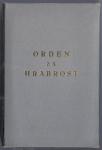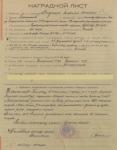-
Posts
552 -
Joined
-
Last visited
-
Days Won
2
Content Type
Profiles
Forums
Blogs
Gallery
Events
Store
Everything posted by Gunner 1
-

British Victory Medals
Gunner 1 replied to Kev in Deva's topic in Inter-Allied Victory Medals of the Great War
davidck: As you indicate it is sometimes difficult to tell the difference. Type II VMs which have lost their gilt or have been subjected to chemicals or smoke can sometimes look like a Type I. In those cases the only way to tell which type you are dealing with is to look closely at the suspension. A Type I VM to a Lieutenant was sold on eBay last week and had nice photos (see eBay item 191029335680). -

Italy - War Merit Cross varieties
Gunner 1 replied to tjnier's topic in Southern European & Balkan States
The feature article in the January-February 2014 issue of JOMSA: The Journal of the Orders and Medals Society of America that went to the printers' this morning is "The Italian War Merit Cross (Merito di Guerra)" by Thomas J. Nier. The issue should be in the hands of OMSA members by the end of the month. Regards, Gunner 1 -

British Victory Medals
Gunner 1 replied to Kev in Deva's topic in Inter-Allied Victory Medals of the Great War
Mike: An interesting chart that must have been produced after MM and MC were authorized but before the 1914 Star, BWM and VM were. Note that the ribbon is referred to as the 'Allied Colours' not the 'Victory Medal' and is next two an unofficial ribbon called France and Belgium. Regards, Dick Flory -

British Victory Medals
Gunner 1 replied to Kev in Deva's topic in Inter-Allied Victory Medals of the Great War
Mike: Thanks for your reply. It would be interesting to know the ribbon chart and the book references to which you refer. I have not seen that ribbon listed in any of the major publications on ribbons or medals as an officially issued ribbon. A few years ago I wrote an article for the OMRS Journal on the Type 1 Victory Medal and had access to most, if not all, of the documents on the Victory Medal in The National Archives at Kew and I was unable to find any reference to the ribbon in question. I think the proponderence of evidence is on the side of it being issued by French tailors to soldiers prior to the official ribbon being available, but would be quite interested in any documentation that refutes that proposition. Regards, Gunner 1 -

British Victory Medals
Gunner 1 replied to Kev in Deva's topic in Inter-Allied Victory Medals of the Great War
Lambert: I do not have photos at the moment. The ribbon bar is not currently in my possession but I will try to get some photos. -

British Victory Medals
Gunner 1 replied to Kev in Deva's topic in Inter-Allied Victory Medals of the Great War
I know -

British Victory Medals
Gunner 1 replied to Kev in Deva's topic in Inter-Allied Victory Medals of the Great War
I don't think that was ever a 'short-lived' VM ribbon; rather it appears to be a ribbon that French tailors sold to Allied soldiers prior to the official Victory Medal ribbon being available for wear. My uncle, an American doughboy, had one on his ribbon bar also that he had purchased before leaving France for home. Gunner 1 -

Yugoslavia Different types of Yugoslav Order of Bravery
Gunner 1 replied to paja's topic in Southern European & Balkan States
paja: There is a number written on the bottom of the box and it matches the number on the medal. -

Yugoslavia Different types of Yugoslav Order of Bravery
Gunner 1 replied to paja's topic in Southern European & Balkan States
paja: Looking at the catalogue for the Rauch sale you appear to be correct as they show both the box illustrated in post #4 and the one in my post as being associated with the Soviet Order of Bravery. -

Yugoslavia Different types of Yugoslav Order of Bravery
Gunner 1 replied to paja's topic in Southern European & Balkan States
The two boxes do look somewhat alike. I have no documentation for either of the awards that I posted and have no way of verifying whether the boxes actually came with either of the awards or were added later. -

Yugoslavia Different types of Yugoslav Order of Bravery
Gunner 1 replied to paja's topic in Southern European & Balkan States
-

Yugoslavia Different types of Yugoslav Order of Bravery
Gunner 1 replied to paja's topic in Southern European & Balkan States
-

Yugoslavia Different types of Yugoslav Order of Bravery
Gunner 1 replied to paja's topic in Southern European & Balkan States
-

Yugoslavia Yugoslavian Partisan Stars
Gunner 1 replied to Bryan's topic in Southern European & Balkan States
In posts #85 to #87 in this thread I illustrated the Partisan Star and certificate to Soviet Lieutenant Anatolii Ivanovich Akulshin. Just discovered that he was also awarded an Order of the Red Star by the Soviets. -

154 Siege Battery, Royal Garrison Artillery
Gunner 1 replied to jasmor58's topic in The Great War 1914 to 1918
According to the CWGC he is MS/118971 Sjt. Lachlan McLean Crawford (note the different service number). While he served with 161st Siege Battery, RGA, his number indicates that he was actually a member of the Army Service Corps and part of the 402nd Mechanical Transport Company, ASC. He was one of the ASC men attached to 161st Siege Battery, RGA to maintain and drive the Holt tractors that towed the battery's four 9.2" howitzers. A detachment of ASC was attached to many siege batteries because of the heavy guns they used. Unfortunately the war diary of 161st Siege Battery has not been traced and I am not aware of a unit history for the unit. At the time of his death the battery was attached to 77th Heavy Artillery Group and their war diary is available at The National Archives under WO 95/324. Gunner 1 -

British Victory Medals
Gunner 1 replied to Kev in Deva's topic in Inter-Allied Victory Medals of the Great War
As there must have been many dies used to produce the British Victory Medal it would not be unusual to find minor variations in medal design. Gunner 1 -

Soviet THE SOVIET QUIZ - 2011 - QUIZ CLOSED
Gunner 1 replied to JimZ's topic in Russia: Soviet: Other Militaria
Jim: Please remove my score and user name from the list of contestants in the Soviet Quiz as I wish to no longer participate. I might mention to Harvey that the phrase 'who touched the face of God" has nothing to do with cosmonauts or astronauts as it was coined by Flight Officer John Gillespie Magee, Jr. in his poem "High Flight" and he died in 1941 well before the term cosmonaut or astronaut was even thought of. It was fun while it lasted but it is time for me to go. Gunner 1 -

Soviet THE SOVIET QUIZ - 2011 - QUIZ CLOSED
Gunner 1 replied to JimZ's topic in Russia: Soviet: Other Militaria
Harvey: It may not be the answer you were looking for, but it fulfills all of the points of your question. It was first flown in 1961; only one was ever built; and it was flown by those "who touched the face of God" (i.e. pilots). Gunner 1 -

Soviet THE SOVIET QUIZ - 2011 - QUIZ CLOSED
Gunner 1 replied to JimZ's topic in Russia: Soviet: Other Militaria
The Tupolev Tu-119 -

Soviet THE SOVIET QUIZ - 2011 - QUIZ CLOSED
Gunner 1 replied to JimZ's topic in Russia: Soviet: Other Militaria
Jim: You are correct! Regards, Gunner 1 -

Soviet THE SOVIET QUIZ - 2011 - QUIZ CLOSED
Gunner 1 replied to JimZ's topic in Russia: Soviet: Other Militaria
Question #74: I was born in the town that now bears my name. Originally trained at a technical school, I worked as a stoker on river boats, but that is not the occupation in which I became famous. One of the things that first made me famous involved the state of Washington. Who am I? What is my connection with the state of Washington? What was my final act? -

Soviet THE SOVIET QUIZ - 2011 - QUIZ CLOSED
Gunner 1 replied to JimZ's topic in Russia: Soviet: Other Militaria
The name of the Tuvinian Hero of the Soviet Union is Adyg-Tulush Baldanovich Kechil-ool, the commander of the Tuvinian Cavalry Squadron that fought with the Russians in the Ukraine. http://en.tuvaonline.ru/2010/05/20/1900_unitedrussia.html -

Soviet THE SOVIET QUIZ - 2011 - QUIZ CLOSED
Gunner 1 replied to JimZ's topic in Russia: Soviet: Other Militaria
I should have listed my major reference: http://www.schudak.de/timelines/tannutuva1911-1944.html -

Soviet THE SOVIET QUIZ - 2011 - QUIZ CLOSED
Gunner 1 replied to JimZ's topic in Russia: Soviet: Other Militaria
The order in the photograph is the Order of the Tuvinian People's Republic Your second question is invalid as a few hundred Tuvinian soldiers participated in the Russian civil war and on 22 May 1943 a Tuvinian Infantry Regiment and Cavalry Squadron began service with the Soviet Army and numerous Tuvinian tankmen were trained by, and served with, the Soviet Army during the Great Patriotic War. One Tuvinian soldier was made a Hero of the Soviet Union. As 33 Russians and 72 Tuvinians were awarded the Order I would say that it a matter of opinion as to which of those recipients 'was the most famous.' My personal choice would be the Tuvinian soldier who was made an HSU. Regards, Gunner 1 -

Soviet THE SOVIET QUIZ - 2011 - QUIZ CLOSED
Gunner 1 replied to JimZ's topic in Russia: Soviet: Other Militaria
ub6365: Absolutely right! I thought someone would eventually figure out the "ass/donkey" and "rat" hints. It was also called the "fly' (rata) by the Republicans in Spain and the "flying squirrel" (Siipiorava) by the Finns. For more info see: http://en.wikipedia.org/wiki/Polikarpov_I-16 Regards, Gunner 1







